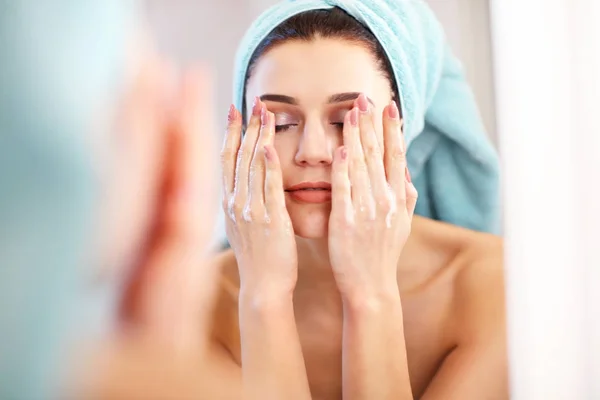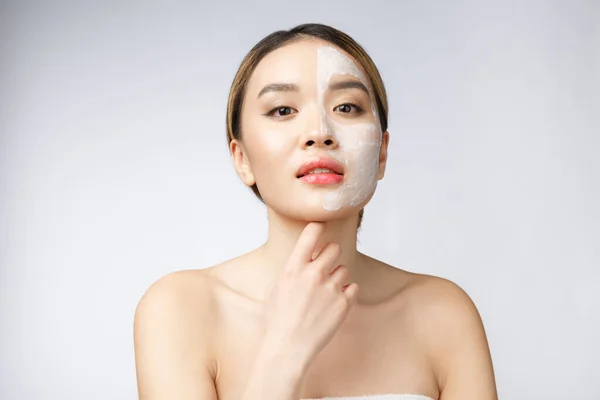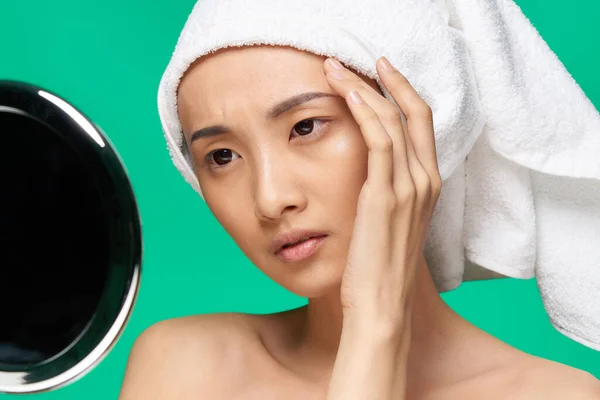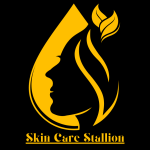“Should I ice my face before or after skincare to maximize the benefits and achieve a glowing complexion?”
The beauty world is buzzing with debates and discoveries, but one question has frosted its way to the forefront: “Should I ice my face before or after skincare?” Imagine a simple cube of ice holding the potential to transform your skincare routine, promising to tighten pores, reduce puffiness, and give you that coveted glow.
Yet, the timing of this chilly ritual remains a hot topic. Join us as we delve into the cool complexities of facial icing, exploring whether it should precede or follow your favorite serums and moisturizers, and uncover the science behind this frosty phenomenon.

Table of Contents
ToggleShould I Ice My Face Before Or After Skincare
Should I Ice My Face Before or After Skincare?
You should ice your face before starting your skincare routine. Icing your face beforehand can help reduce inflammation, minimize pores, and create a smoother canvas for your skincare products. This practice can enhance the absorption and effectiveness of your serums and moisturizers.
It also soothes the skin, making it more receptive to active ingredients. Therefore, incorporating icing as the first step ensures you maximize the benefits of your skincare regimen.
Benefits of Icing Your Face Before Skincare
Icing your face before applying skincare products offers numerous advantages. The cold temperature from the ice helps to constrict blood vessels and reduce puffiness, making your skin appear more toned and less inflamed. This step is particularly beneficial in the morning, as it can invigorate the skin and reduce any overnight swelling. Moreover, the cold sensation can temporarily tighten your skin, giving it a firmer appearance. By minimizing pores, icing also creates a smooth surface that allows skincare products to penetrate deeper and work more effectively.
How to Incorporate Ice into Your Skincare Routine
Incorporating ice into your skincare routine is simple and effective. Start by thoroughly cleansing your face to remove any dirt and oil. Wrap an ice cube in a soft cloth or use a dedicated facial ice roller to avoid direct contact with the skin, which can cause damage.
Gently glide the ice over your face in circular motions for a few minutes, focusing on areas prone to puffiness and large pores. After icing, pat your skin dry with a clean towel and proceed with your usual skincare steps, such as applying toner, serum, and moisturizer. The cold treatment will prepare your skin to better absorb these products, enhancing their benefits.
Common Questions and Concerns
Many people wonder about the optimal time for icing within their skincare routine. The primary concern is whether the cold temperature will interfere with the efficacy of active ingredients in their products. However, when done before applying skincare products, icing actually enhances the absorption of ingredients like hyaluronic acid, vitamin C, and retinol.
Another common question is about the frequency of icing. While daily icing can be beneficial for some, those with sensitive skin might prefer to limit the practice to a few times a week to avoid irritation.
Benefits of Icing the Face
Icing the face offers a multitude of benefits that promote skin health and radiance. One of the primary advantages is its ability to reduce inflammation and swelling, making it an effective remedy for puffiness and redness.
Additionally, it improves blood circulation, which can enhance the natural glow of the skin. The cooling effect of ice helps tighten the skin and minimize pores, contributing to a smoother complexion. Furthermore, it provides a soothing sensation, relieving stress and fatigue from facial muscles.
Overall, regular icing sessions can significantly enhance skin radiance, leaving your face looking refreshed and rejuvenated. Integrating ice into your skincare routine can lead to noticeable improvements in skin tone and texture over time.
General Skincare Routine Components
A well-rounded skincare routine consists of several essential components, each playing a crucial role in maintaining healthy skin.
Cleansing
Is foundational, involving various types of cleansers such as foaming, gel, or oil-based formulas. Removing dirt, oil, and impurities is vital for preventing clogged pores and acne breakouts.
Toning
Complements cleansing by balancing the skin’s pH and tightening pores. Toners, including hydrating and astringent varieties, prepare the skin for better absorption of subsequent products.
Moisturizing
Is essential for hydration and protecting the skin barrier. Moisturizers, ranging from creams to lotions to gels, help retain moisture and prevent dryness.
Additional steps
Like serums and treatments target specific concerns such as aging or hyperpigmentation. Sunscreen is crucial for daily protection against UV rays, while exfoliation and masks enhance skin texture and clarity.
Each step contributes uniquely to a comprehensive skincare regimen, ensuring skin remains healthy, balanced, and radiant. Adopting these practices helps maintain skin integrity and addresses common concerns effectively.
Icing Before Skincare
“Icing before skincare” is gaining popularity in beauty routines for its potential benefits. Firstly, it enhances the absorption of skincare products, allowing active ingredients to penetrate deeper into the skin. Secondly, it provides an immediate reduction in puffiness by constricting blood vessels temporarily. Additionally, icing prepares the skin by tightening pores, creating a smooth canvas for subsequent skincare applications.
However, there are some potential drawbacks to consider. Icing can temporarily constrict blood vessels, which may reduce blood flow and impact overall skin health if done excessively. There’s also a concern that icing might interfere with the penetration of certain skincare products, especially if they rely on warmth for optimal absorption.
For best results, consider incorporating icing into your morning skincare routine to promote wakefulness and reduce morning puffiness. It can also be beneficial before applying makeup, as it helps to tighten the skin and improve makeup application.
Incorporating “icing before skincare” strategically can enhance your skincare regimen, offering immediate benefits like reduced puffiness and improved product absorption, while being mindful of potential drawbacks such as temporary blood vessel constriction.
Comparative Analysis
Immediate Effects vs. Long-term Benefits
Skincare products often promise immediate effects and long-term benefits. Immediate effects include hydration, radiance, and a smoother complexion. These quick results can boost confidence and satisfy short-term needs.
Long-term benefits, however, focus on reducing fine lines, preventing breakouts, and enhancing overall skin health. Effective skincare routines balance both aspects. Using keywords like “anti-aging,” “acne prevention,” and “skin texture improvement” highlights the importance of a comprehensive approach.
Personal Skin Types and Conditions
Oily vs. Dry Skin
Understanding your skin type is crucial for effective skincare. Oily skin tends to produce excess sebum, leading to acne and a shiny appearance. Common phrases include “oil control” and “matte finish.” Dry skin, on the other hand, lacks moisture and can feel tight or flaky.
Terms like “deep hydration” and “nourishing” are essential when describing products for dry skin. Tailoring your routine to your skin type ensures optimal results.
Sensitive Skin Considerations
Sensitive skin requires extra care. It reacts easily to harsh ingredients, causing redness, itching, and discomfort. Phrases like “gentle formula,” “fragrance-free,” and “hypoallergenic” are important when choosing products. Patch testing and gradual introduction of new products can prevent adverse reactions. Keywords such as “soothing,” “calming,” and “allergy-tested” emphasize the need for careful product selection.
Lifestyle and Routine Preferences
Time of Day
The time of day affects skincare routines. Morning routines often focus on protection and hydration. Keywords like “sunscreen,” “moisturizer,” and “antioxidant serum” are popular. Evening routines typically aim at repair and renewal. Terms such as “night cream,” “retinol,” and “repair serum” are frequently used. Adjusting your skincare routine to the time of day maximizes its effectiveness.
Frequency of Skincare Routine
Frequency is another critical factor in skincare. Daily routines ensure consistent care and maintenance. Phrases like “daily cleanser,” “regular exfoliation,” and “consistent routine” are commonly used. Some treatments, like masks or intensive serums, are best used weekly.
Keywords such as “weekly treatment,” “deep cleanse,” and “intensive care” highlight these practices. Balancing daily and weekly routines provides comprehensive skin care.
Expert Opinions and Studies
Expert Opinions and Studies on Facial Icing
Dermatologists’ Perspectives
Dermatologists often recommend facial icing for its benefits in reducing inflammation and swelling. Leading skin experts highlight its effectiveness in soothing irritated skin and minimizing puffiness.
Many dermatologists emphasize that facial icing can constrict blood vessels, which helps to reduce redness and improve skin texture. This cold therapy technique is frequently endorsed in skincare routines to enhance overall skin health.
Clinical Studies on Facial Icing
Clinical studies on facial icing support its role in improving skin appearance. Research shows that cold treatments can decrease inflammation and accelerate skin healing. Controlled trials have demonstrated that facial icing reduces symptoms of acne and enhances the absorption of skincare products.
These studies provide scientific validation for incorporating facial icing into daily beauty regimens. The clinical evidence highlights the safety and efficacy of this simple yet powerful technique.
Anecdotal Evidence and Testimonials
Anecdotal evidence and testimonials from users of facial icing reveal widespread satisfaction with the results. Many individuals report noticeable improvements in skin tone and reduced puffiness after regular use. Testimonials frequently mention how facial icing helps to wake up the skin and provides a refreshing start to the day.
Personal stories and reviews emphasize its role in achieving a youthful and radiant complexion. This positive feedback underscores the popularity and perceived benefits of facial icing in everyday skincare routines.
Practical Tips for Facial Icing
Proper Technique
Using Ice Cubes, Ice Rollers, or Cold Compresses
To effectively ice your face, you can use ice cubes, ice rollers, or cold compresses. Each method offers unique benefits. Ice cubes are easy and quick to use, providing immediate cooling relief. Ice rollers, designed specifically for facial use, help evenly distribute cold and reduce puffiness. Cold compresses are great for soothing and can be infused with beneficial ingredients.
Duration and Frequency
For optimal results, limit facial icing to 1-2 minutes per session. Over-icing can damage skin cells and cause irritation. It’s recommended to ice your face once or twice daily. Consistency is key for reaping the anti-inflammatory and pore-tightening benefits of facial icing.
Safety Precautions
Avoiding Ice Burns
To prevent ice burns, never apply ice directly to your skin. Wrap ice cubes in a clean cloth or use ice rollers that have a protective surface. This barrier reduces the risk of frostbite and skin damage. Always move the ice in gentle, circular motions to avoid concentrated cold exposure.
Suitable Alternatives for Sensitive Skin
For sensitive skin, consider alternatives like cool, damp cloths or gel-based cold packs. These provide a gentler cooling effect and reduce the risk of irritation. Products designed for sensitive skin can offer soothing benefits without the harshness of direct ice.
Incorporating Icing into Your Routine
Customizing Based on Skin Needs
Tailor your icing routine to your skin’s specific needs. If you have acne-prone skin, focus on inflamed areas to reduce swelling. For anti-aging benefits, use an ice roller to stimulate circulation. Listen to your skin’s response and adjust the frequency and duration accordingly.
Monitoring Skin’s Reaction
Always monitor your skin’s reaction to icing. Look out for signs of excessive redness, discomfort, or irritation. If any adverse effects occur, reduce the icing time or frequency. It’s crucial to ensure that facial icing benefits your skin without causing harm.
Facial icing can rejuvenate your skin, reduce puffiness, and enhance your skincare routine. Use these practical tips to achieve the best results while keeping your skin safe and healthy.


FAQs
Should I ice my face before or after skincare routines?
It’s generally recommended to ice your face before applying skincare products. This helps to reduce inflammation and temporarily tighten pores, enhancing the absorption of skincare ingredients.
How long should I ice my face before skincare?
Aim for about 1-2 minutes of icing before starting your skincare routine. This duration is enough to constrict blood vessels and prep the skin without causing discomfort.
Can icing after skincare routines be beneficial?
Yes, icing your face after skincare can help seal in the products and reduce any post-application swelling or redness. However, it’s essential to be gentle and use a soft cloth or ice roller to avoid irritation.
What are the benefits of icing before skincare?
Icing before skincare can temporarily tighten pores, reduce puffiness, and enhance the effectiveness of skincare products by improving their penetration into the skin.
Should I use ice directly on my skin?
No, it’s not advisable to apply ice directly on the skin. Wrap ice cubes in a soft cloth or use an ice roller to prevent potential skin damage or frostbite.
How often can I ice my face?
It’s safe to ice your face daily, especially in the morning before applying skincare products, to help wake up the skin and reduce morning puffiness.
Can icing help with acne?
Yes, icing can temporarily reduce inflammation and redness associated with acne. It can also soothe irritated skin and minimize the appearance of acne lesions.
Should I ice my face if I have sensitive skin?
If you have sensitive skin, be cautious with icing. Use a gentle approach with shorter icing sessions to avoid overstimulating or irritating your skin.
Is there a specific technique for icing the face?
Start from the center of your face and move outwards in gentle, circular motions. Focus on areas prone to puffiness, like under the eyes and along the jawline.
Can I use ice substitutes like ice packs or chilled spoons?
Yes, you can use alternatives like ice packs or chilled spoons if you prefer. Ensure they are not too cold and always wrap them in a soft cloth to protect your skin.
conclusion
In conclusion, the decision to ice your face before or after your skincare routine ultimately depends on your specific skin needs and goals. Icing before applying skincare products can help to reduce puffiness, calm inflammation, and tighten the skin, potentially enhancing the absorption of subsequent products.
On the other hand, icing after applying skincare can help to seal in the products, reduce redness, and provide a soothing effect. Both methods have their benefits, and you may even find that alternating between the two or combining them yields the best results for your skin.
As with any skincare regimen, it’s important to listen to your skin and adjust your routine accordingly. Consulting with a dermatologist can also provide personalized guidance tailored to your skin type and concerns.
